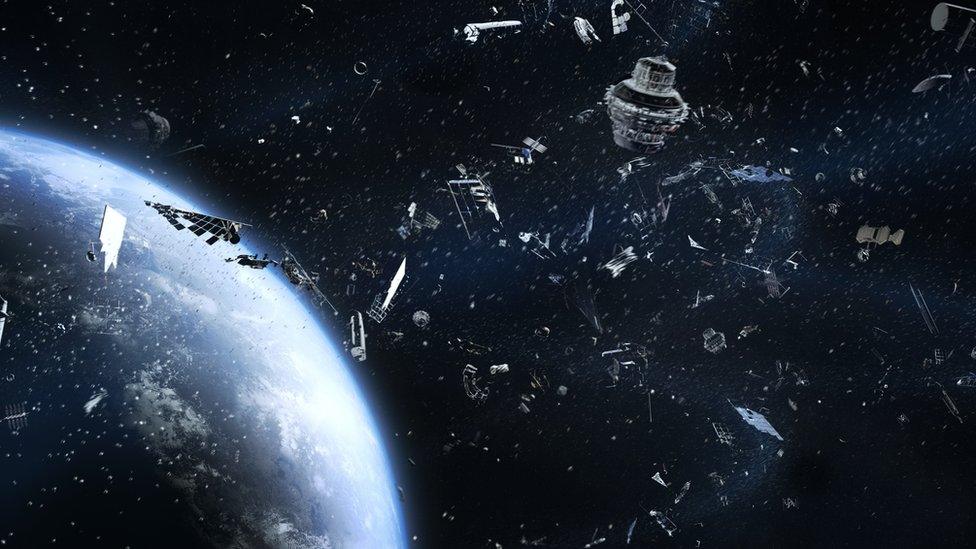Why are people talking about space junk?
- Published
- comments

Space junk has become an increasing concern over the years
Space missions have become pretty common nowadays, and there's no sign of things slowing down as technologies become more and more advanced.
It's an exciting time for those interested in exploring life beyond planet Earth, but it's also caused some concerns about the increasing amount of congestion and pollution in space.
The increase of satellites being sent up into the skies, and more and more 'space junk' is concerning experts.
Now, a group of scientists have called for the space around Earth to be protected by environmental rules and regulations, similar to those that look after the planet's land, seas and air.
What's been said about space junk?
America's vice-president Kamala Harris spoke about the harmful effects of missile tests at the Vandenberg Space Base in California
Space junk is when objects made by humans like bits of machinery, old satellites or rockets are left floating around in space.
The United States recently became the first country to announce plans to ban missile tests which are used to destroy old or unwanted satellites in space.
The US, China, India and Russia have all carried out these tests in the past, producing lots of space debris in the process.
Last November, members of the International Space Station (ISS) had to take shelter after Russia destroyed a satellite, producing 1,632 pieces of space debris, according to a US Space Force database of orbital objects.
America's vice-president Kamala Harris said the missile tests were reckless and irresponsible.
Jenny explains what space junk is and why it's causing problems
"Simply put, these tests are dangerous, and we will not conduct them," she said speaking at the Vandenberg Space Base in California, USA.
"This debris presents a risk to the safety of our astronauts, our satellites and our growing commercial presence," she said.
"A piece of space debris the size of a basketball, which travels at thousands of miles per hour, would destroy a satellite. Even a piece of debris as small as a grain of sand could cause serious damage."
The vice-president also urged other countries to agree to become more responsible when it comes to their behaviour in space.
An increasing number of satellites are being sent into space
A group of scientists from countries around the world have also published a new paper calling for the space around Earth to be protected.
"Damage to the orbital space environment has problematic features in common with other types of environmental issues," the paper states.
The group of researchers say more and more satellites are being sent into space and they think the current practices suggest this number could reach 100,000 by 2030.
"Of the many thousands of satellites that have been launched over the years, most have re-entered, exploded, or continue to orbit the Earth as derelicts, along with other leftover rocket parts," the paper says.
This is about recognising that the problems we see in orbit are the same as those we see when we worry about the land, the oceans and the atmosphere. We need to knock heads together and say how can we solve this problem.
Elon Musk's space company SpaceX has launched a large number of satellites into space over the last two years
So far, more than 22,400 pieces of space debris including old satellites and pieces from destroyed space objects have been recorded.
The paper suggests that like climate change, current practices could have some major effects on the space environment if not addressed soon.
Writing in the scientific journal Nature Astronomy, scientists from the UK, US, Canada and the Netherlands warn the number of satellites in low Earth orbit could affect the work of astronomers and change how we see the sky, as the number of satellites seen as "fake stars" starts to rival the number of real stars seen with the naked eye.
"We really need to get our act together. We need to see where have we got regulations that we're not applying properly, and where do we need new regulations?" said the lead author, Andy Lawrence, a professor of astronomy at the University of Edinburgh.
- Published5 March 2022
- Published20 March 2021
- Published28 April 2021
